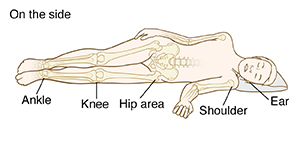What Are Pressure Injuries?
Pressure injuries (pressure ulcers, pressure sores, or bedsores) happen when pressure on your skin cuts off your blood supply. This usually happens in areas where your bones are closer to the surface (bony prominences). This makes your skin and the tissue below your skin break down. Pressure injuries often happen if you lie or sit in one position for too long. They can be painful and heal slowly. But you can do many things to help stop pressure injuries.
Who’s at risk
Anyone who can’t move around on their own is at risk for pressure injuries. The biggest risk factors are:
Other risk factors include:
-
Skin irritation from loss of bladder or bowel control
-
Poor nutrition
-
Vascular disease
-
Loss of feeling in the skin
-
Smoking
-
Diabetes
-
Older than 65 years of age
-
Local infection
-
Dementia
Your role
Your role is to prevent pressure injuries from forming. That means you need to:
-
Change positions often.
-
Limit the time you spend sitting in one place.
-
Get up and move around or walk as much as possible.
-
Support your body by using cushions or pillows.
-
Don't rub or slide when you move in bed or in a chair.
-
Keep your skin clean and dry.
-
Wear clothing that fits. Don't wear clothing that is loose and bunches up under you or that is too tight.
-
Eat a healthy diet and get enough movement.
-
Check your skin twice a day for signs of breakdown.
-
Manage your diabetes and other health conditions that make you more likely to have a pressure injury.
Where pressure sores occur
Pressure sores form where bone presses your skin against a bed or chair. This is most likely to happen in places where there is less padding between the skin and the bone. This includes your head and feet, and around joints like your shoulder, hip, and knee.



When to call your healthcare provider
Call your healthcare provider when you first see any of the following:
-
Redness that doesn’t go away after the pressure source is removed
-
Cracked, blistered, or broken skin
-
Red, shiny skin that is painful or warm to the touch, or that feels spongy or hard
-
Skin that has lost feeling (sensation)
-
Darkened area of skin
-
Any wound with drainage or that has a bad odor
Online Medical Reviewer:
Jonas DeMuro MD
Online Medical Reviewer:
Raymond Turley Jr PA-C
Online Medical Reviewer:
Tara Novick BSN MSN
Date Last Reviewed:
8/1/2022
© 2000-2024 The StayWell Company, LLC. All rights reserved. This information is not intended as a substitute for professional medical care. Always follow your healthcare professional's instructions.